
views
X
Research source
Read on to learn what characteristics to look at and what graphology tells you those characteristics mean. If you want to test it on yourself, write out a few sentences on blank, unlined paper so you can analyze as you go.
- Writing with rounded letters can be a sign you're relaxed and open-minded. Writing with rigid, pointy letters can mean you're tense.
- Dotting your i's further away from the stem could mean you're imaginative. I-dots closer to the stem can mean you're organized and methodical.
- Crossing your t's lower on the stem could be a sign of low self-esteem, while t-bars high on the stem indicates very high self-esteem.
- Using heavy pen pressure could signal you're energetic or emotional. Light pen pressure might indicate you avoid confrontation.
Shape of Letters
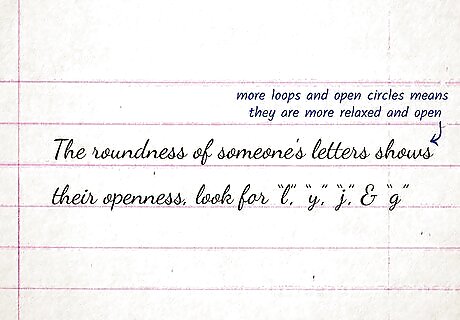
The roundness of someone's letters shows their openness. The more loops and open circles in someone's writing, the more relaxed and open they are. In contrast, people who write with straight lines rather than a lot of loops tend to be tenser. The lower-case "L" is a good place to look for this, as well as letters that drop below the baseline (such as "y," "j," and "g"). Rounded letters might also signify someone who's more artistic and creative, while pointy letters indicate someone who's more rational and aggressive. More rounded letters are also seen as more feminine, while strong lines and sharp angles are seen as masculine.
Position and Shape of i-dots
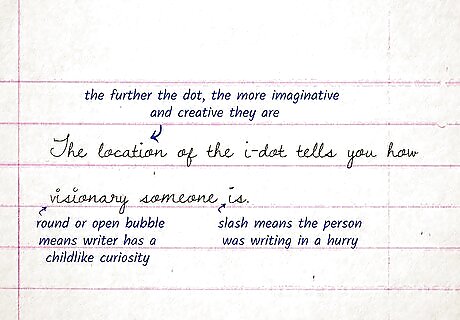
The location of the i-dot tells you how visionary someone is. Generally, the further away from the stem a person dots their i's, the more imaginative and creative they're seen to be. This makes sense if you recall that the top of the page represents dreams and goals. An i-dot closer to the stem means the writer is organized and pays attention to detail. If the i-dot is more of a slash than a dot, it could mean that the person was writing quickly or that they're a pretty rushed and impatient person in general. Is the i-dot a round, open bubble? The writer has a childlike curiosity about the world and is likely very bubbly and creative.
Position and Shape of T-bars
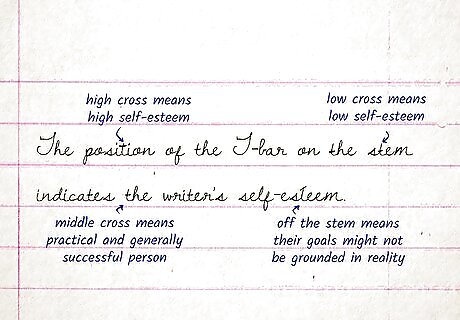
The position of the T-bar on the stem indicates the writer's self-esteem. If the person crosses their lowercase T's high on the stem (above the tops of other letters), they have very high self-esteem. If it's crossed very low, that could indicate that they fear failure and resist change. T-bars consistently crossed in the middle, just above the tops of the other lowercase letters, signal a practical and generally successful person. Someone who's a dreamer might cross their T's completely off the stem. Their goals might not be grounded in reality and they might be prone to flights of fancy.
Size and Proportion of Letters
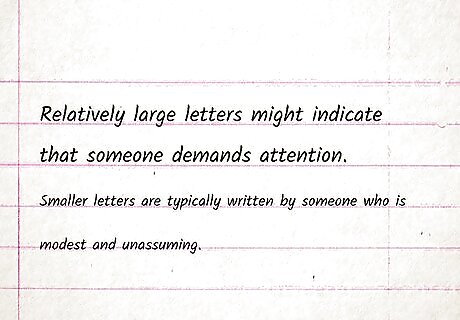
The size of a writer's letters shows how they fit in with their environment. Graphologists divide a line of writing into 3 zones— the upper, middle, and lower zones. To look at the size of someone's writing, focus mainly on the middle zone, where the majority of lower-case letters are located. Relatively large letters might indicate that someone demands attention, while smaller letters are typically written by someone who is modest and unassuming. Small handwriting can also indicate someone with strong focus and concentration who tends to work on one thing at a time rather than multi-tasking.
Letter Slant
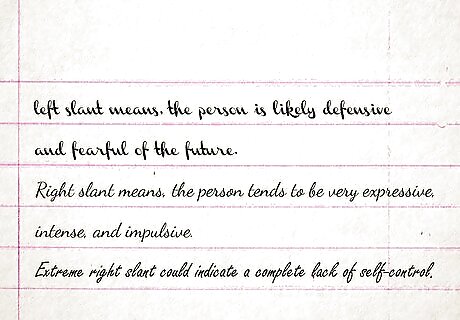
The slant of a person's letters tells you their emotional direction. If the letters themselves angle back to the left, the person is likely defensive and fearful of the future. If the letters angle forward to the right, on the other hand, the person tends to be very expressive, intense, and impulsive. People who write their letters straight up and down value rationality over emotion and tend to be fairly independent. How much the letters are slanted also gives you a clue into how far in that direction the person leans—so an extreme right slant could indicate a complete lack of self-control.
Letter Spacing
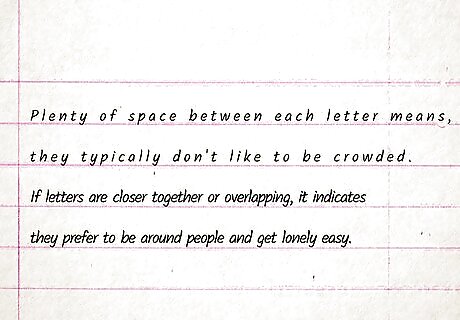
The space between letters shows the writer's need for personal space. Someone who writes with plenty of space between each letter typically doesn't like to be crowded and needs a lot of personal space. If their letters are closer together or even overlapping, it indicates they prefer to be around people and get lonely easy. People whose letters are crowded close together might also have a hard time giving others the personal space they need.
Word Spacing
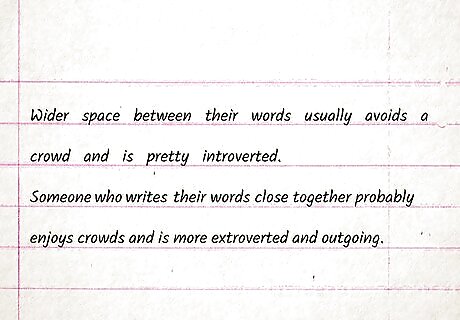
The space between words relates to how sociable someone is. A writer who leaves a wider space between their words usually avoids a crowd and is pretty introverted. In contrast, someone who writes their words close together probably enjoys crowds and is more extroverted and outgoing. Some graphologists interpret a narrow space between words to indicate the writer has a tendency to pry into others' personal lives or ask intrusive questions.
Line Spacing
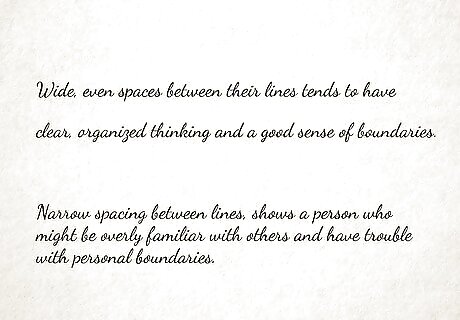
How someone spaces their lines shows how they react in relationships. Someone who leaves wide, even spaces between their lines tends to have clear, organized thinking and a good sense of boundaries. Narrow spacing between lines that causes letters to overlap, on the other hand, shows a person who might be overly familiar with others and have trouble with personal boundaries. Narrow-based lines can also indicate a tendency toward knee-jerk reactions, while someone with wide-spaced lines is more likely to hold back until they've cooled off.
Baseline Slope
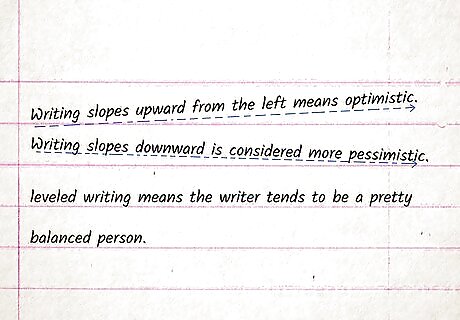
The slope of the lines gives insight into the writer's outlook on life. A person whose writing slopes upward from the left is generally optimistic, while someone whose writing slopes downward is considered more pessimistic. If their writing is generally level, they tend to be a pretty balanced person. The baseline slope is usually more of an indicator of the person's mood while they were writing, rather than their overall personality. If you want to analyze a person's overall personality, get several different samples from different days and times.
Pen Pressure

Pen pressure tells you how much physical and emotional energy the writer exerts. People who write with heavy pressure tend to have strong vitality and intense emotions. Those who write with very light pressure, on the other hand, are more passive or sedentary and likely avoid confrontation. Most people write with medium pressure, indicating more of a balance. Someone who writes with heavy pressure usually also writes pretty slowly, while people who write with light pressure are often writing very quickly. As with the baseline slope, you need several handwriting samples to interpret the writer's personality as a whole. Otherwise, this just reflects how they're feeling in the moment.
Margins
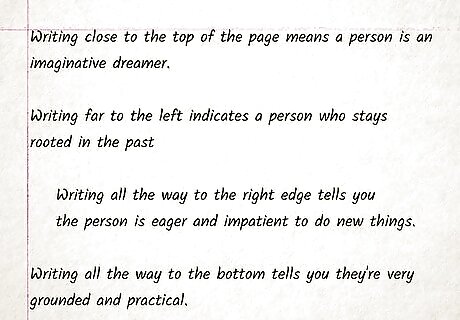
The space a person uses to write corresponds to their orientation in time. Writing far to the left indicates a person who stays rooted in the past, while writing all the way to the right edge tells you the person is eager and impatient to do new things. Writing close to the top of the page means a person is an imaginative dreamer, while writing all the way to the bottom tells you they're very grounded and practical. Some graphologists interpret the writing of a person who leaves little to no margins all the way around to mean that person is insecure. Those who leave a very even margin around all sides of their writing are thought to be balanced and self-disciplined people.















Comments
0 comment